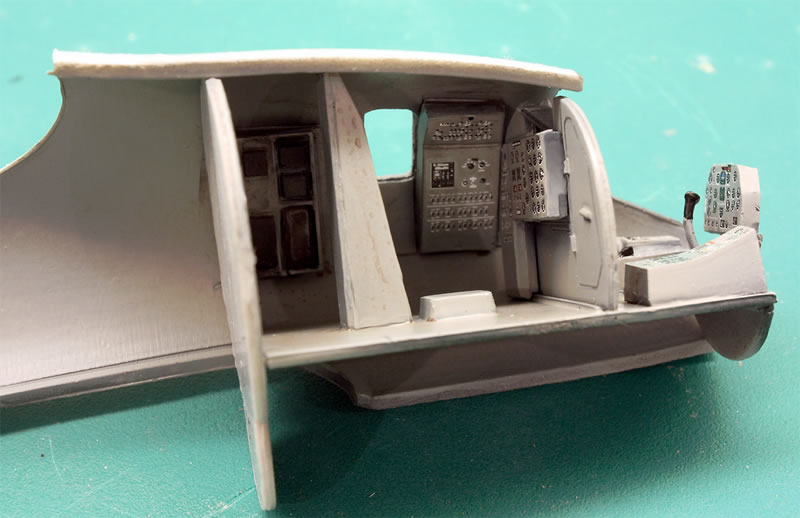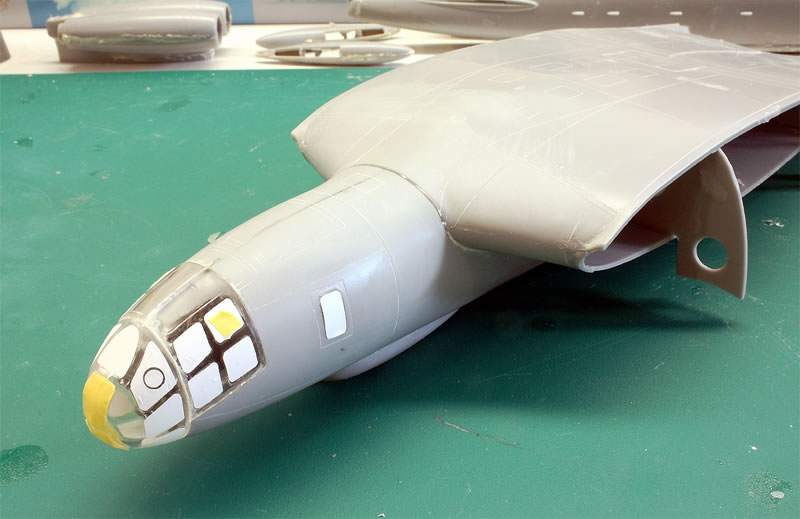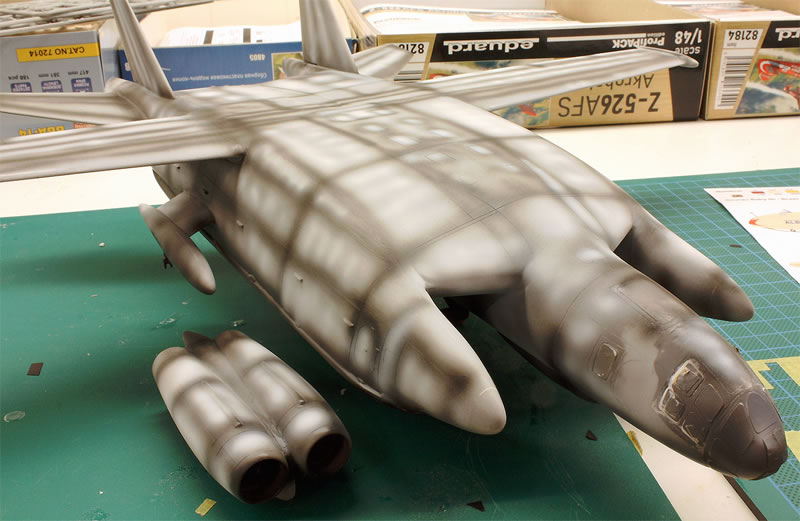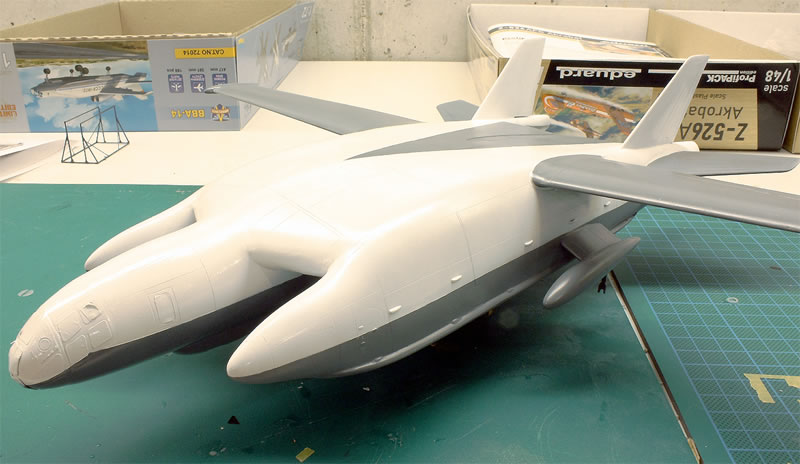Mikro Mir 1/72 scale
Bartini-Beriev WWA-14 M1
by Roland Sachsenhofer

When looking at some of the flying machines, the question immediately arises as to how anyone could believe that something like this would ever take off! In fact, the original of the WWA-14 M1 shown here has flown - and not at all badly, as will be described later. The curious gaze is puzzled by the strange design and lingers on the unusual detailed shapes of this flying monster: are we looking at a watercraft or hovercraft, a flying boat or something even more exotic?
To the original: the Bartini-Beriev WWA-14 M1
A clue as to what lies behind the striking design can be found in the machine's designation. The abbreviation WWA-14. is derived from wertikalno-wsljotnaja amfibija, meaning a "vertical take-off amphibious aircraft". The number 14 - imagine that! - denotes the originally planned number of (lift and cruise) engines!
As futuristic as this idea already sounds, it becomes even more spectacular: the planned purpose of the WWA-14 was to hunt Western submarines, with the newly emerged threat of US Navy boats equipped with Polaris intercontinental missiles in the 1960s providing the main impetus for development.
The idea was that the submarine hunter could take off vertically from land or water, reach its operational area as a conventional aircraft flying at high altitude and then, now flying low, take up the search and combat of the enemy forces with the extensive submarine hunting equipment it was carrying. The plan was, of course, to equip the aircraft with the latest in Soviet defence technology for engaging underwater targets. The planned weapons consisted of 16 depth charges, 2 torpedoes and 8 sea mines with a total weight of 2000kg. A characteristic feature, which was reflected in the shape of the WWA-14, was added to achieve this purpose: in order to increase range and endurance, the WWA-14 was designed to fly close to the water and use the ground effect to generate buoyancy.
The crew of the WWA-14 consisted of three men: pilot, co-pilot and weapons system officer were positioned in the cockpit in front of the central fuselage; in an emergency, they were to be able to rescue themselves using three KL-36 ejection seats. The fly-by-wire control system, a novelty at the time, supported the pilot's work, although this was not installed until the second prototype.
With this information, the unusual appearance of the WWA-14 is a little easier to understand: the undersides of the two elongated side fuselages serve as floats; incidentally, the first prototype M1, shown here, was still testing a configuration with inflatable floats: in flight, the empty floats were to be retracted to the fuselages in an aerodynamically favourable position. This idea had already been abandoned in the second WWA-14 M2 built, as the necessary mechanics proved to be too problematic at higher speeds. The planned installation of a further 12 lifting engines for vertical flight was no longer realised.
In the second prototype M2, another idea was also realised which was intended to enhance the ground effect: two jet engines were installed on the central part of the fuselage in such a way that they directed their exhaust jet into the space between the two floats, the central fuselage roof and the water surface in order to improve the lift and propulsion of the heavy aircraft.
A quick look at the dimensions and performance data of the WWA-14 makes it clear that we are dealing with a true leviathan. A length of just under 26 metres and a wingspan of 28.50 are matched by an impressive height of 6.80 metres. Unloaded, the VVA-14 already weighed 35,400kg, and with fuel and 2,000kg of weapons it weighed 52,000kg. The two Solowjew D-30M jet engines mounted on the back of the fuselage gave the VVA-14 a top speed of 760 km/h. The service ceiling was 10 metres. The service ceiling was 10,000 metres. The range appropriate for a global submarine hunter is specified as 2450 kilometres.
Several years of resources and energy were invested in the development of this futuristic concept. Robert Bartini was to lead the development of the WWA-14: in 1965, he was commissioned with the conceptualisation of the new submarine hunter, while the flying boat manufacturer Beriev was to produce the components and carry out the flight tests.

The realisation of the complex project took time: the first flight of the WWA-14 M1 took place in 1972 in Taganrog on the Sea of Azov in southern Russia. Testing was initially carried out with a landing gear, later the inflatable floats were installed. The second prototype, the M2, had the two turbines described above at the front of the extended cockpit nacelle and the devices for fly-by-wire control. With the M3, the plan was to continue flight testing with complete equipment and full armament. However, this was not to be the case. By the mid-1970s, interest in the sprawling project had visibly waned, so that after Bartini's death in 1974, testing was discontinued altogether.
Almost at the end: a few words about Robert Bartini
No report on the WWA-14 would be complete without a reference to the man behind this unusual project. Robert(o) Bartini's life and his achievements as an aeroplane designer seem just as extraordinary as his designs. In this context, a collection of key words will suffice: after being born out of wedlock in Fiume in 1897, he was adopted as an infant by an Austro-Hungarian nobleman, served in the First World War and as a Russian prisoner of war, returned as a convinced communist, then became a member of the Italian Communist Party. After Mussolini came to power in 1922, he left for the USSR. Worked in several aeronautical engineering institutions and organisations and produced a number of pioneering designs, publications and constructions. Arrested and sentenced by the NKVD in 1938, imprisoned until his release in 1947. After his imprisonment, he was fully rehabilitated and worked at the Beriev design office, where he was responsible for the development of pioneering and unconventional flying boats. Bartini, who died in 1974, is considered one of the great personalities in aviation history, with the WWA-14 representing the last highlight of his work.
The manufacturer Mikro Mir is always keen to produce extremely unusual aircraft from aviation history. The two WWA-14 M1 and M2 fit perfectly into this concept!



A first glance at the sometimes very large parts quickly makes it clear that an impressively large model will be created. However, the complex structure of the original is also reflected in an impressive number of parts.



A glance at the clear and detailed assembly instructions promises a detailed build - and the modeller will not be disappointed! The multi-part assembly of the two ejection seats alone takes some time and sets the mood for a modelling experience that also requires the mastery of intricate small parts. Care should be taken when separating them from the thick moulded branches.



In my opinion, the accuracy of fit deserves an assessment that varies between "satisfactory" and "just sufficient". Filling compound and sandpaper are faithful companions in all construction phases, and ingenuity and the courage to improvise are also required on several occasions. I am thinking in particular of the assembly of the centre body and the two floats. In particular, attaching the undersides of the floats proved to be a hairy affair for me: here, uncleanly cast, distorted moulds, a lack of fitting accuracy and the size of the (still) unstable model, which had already grown considerably at this point, briefly turned into a challenging scenario. But, as you can imagine, with energetic prudence and plenty of cyanoacrylate and sandpaper, even this cliff could be avoided.


To my relief, the decals worked wonderfully and deliver a very nice result. In conclusion, I can say that apart from the circumstances described, Mikro Mir has put a model in the box that is actually very buildable. Another plus point is the provision of precisely fitting adhesive masks for the clear parts; this really does make the building process much easier.
I am grateful to manufacturers like Mikro Mir for giving me the opportunity to model such rare milestones and exotic aircraft in aviation history! With this in mind, I can warmly recommend the spectacular WWA-14 to anyone who is interested - and wish you lots of fun building it!

If you would like to see the kit and the building process for yourself, you can find a detailed building report on "Scalemates" here:
VVA-14 (1:72) by Roland - Albums (scalemates.com)
As always, I am open to suggestions and questions:
ro.sachsenhofer@gmx.at
Model, Images and Text Copyright ©
2024 by Roland Sachsenhofer
Page Created 11 April, 2024
Last Updated
11 April, 2024
Back to HyperScale Main Page

|
Home
| What's New | Features | Gallery | Reviews | Reference | Resource Guides | Forum |